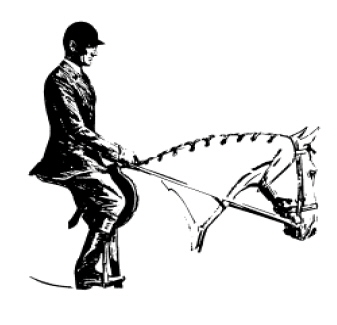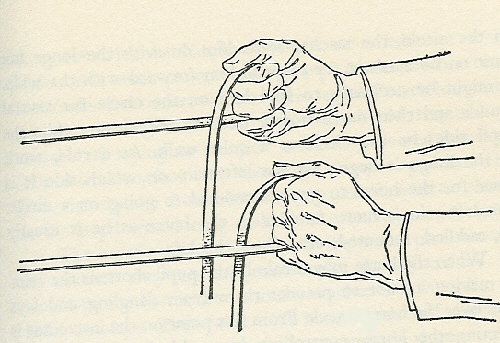IMEHA (International Model Equine Hobbyists Association) was an online photo showing site that existing until 2018. Included on the site were these guidebooks for judging and showing model horses in Performance classes. MEPSA has obtained permission to share the info contained in the guides.
Scoring :: Point Deducts :: Tack :: Rider :: Set-Up Options :: Photo Examples
A horse should demonstrate a willing walk and calmly work over and through all obstacle, showing agility, in control of the rider and on the bit, balance, and ready responsiveness. Horses that shy, pace, above the bridle or otherwise demonstrating excitement or lack of control are not suitable for arena trail. A trail horse should, however, not be a dead head but should show interest in the obstacles. A trail obstacle represents a test and the horse is judged on how well it is meeting that test. The obstacle may test calmness, agility or control. All obstacles test willingness and obedience. Credit will be given to horses negotiating the obstacles with style and some degree of speed, providing correctness is not sacrificed. Horses should receive credit for showing attentiveness to the obstacles and the capability of picking their own way through the course when obstacles warrant it, and willingly responding to the rider’s cues on more difficult obstacles. Gaits are halt, walk, trot, canter and back.
English Trail requires that a horse must be negotiating an obstacle or have just finished working the obstacle, but the obstacle must be clearly visible in the photo frame. No cross entering from Trail Trial or Natural Trail.
You Score English Trail Arena on the following basis:
Obstacles:
Many associations severely limit the obstacles allowed; especially AQHA, ApHA and APHC. However these restricted obstacles are allowed in USAE so unless the entry specifically states the horse is being shown in the restricted breed association approved show then a lenient standard should take precedence. Unless the obstacle is blatantly unsafe. USAE rules state unsafe obstacles are the following: fire extinguishers, perforated plywood in water boxes, exotic wild animals (lions, tigers and bears staked out) or unsafe elements such as hay bales (height too high and horse can stab and foot down into the bale and be unable to pull its foot free.) Not that these items should be banned, but not recommended. A setup with these items should not be eliminated but may be penalized at the judge’s discretion.
Recommended obstacles are as follows:
Approved Obstacles are:
Gate:
Opening, passing through and closing gate. (Losing control of gate is to be penalized.) Use a gate which will not endanger horse or rider. If the gate has a metal, plastic or wooden support bar under the opening, riders must work the gate moving forward through it. If gate has no support under it then horse and rider may back through the gate.
Ground Poles:
Ride over at least four logs or poles. These can be in a straight line, curved, zigzag or raised. The space between the logs is to be measured and the path the horse is to take should be the measuring point. All elevated elements must be placed in a cup, notched block, or otherwise secured so they cannot roll. The height should be measured from the ground to the top of the element. Care should be given to keep in mind the scale for the spacing of real walkovers, trotovers, and lopeovers which are:
(A) The spacing for walkovers shall be 20” to 24” (40 cm to 60 cm) and may be elevated to 12” (30 cm). Elevated walkovers should be set at least 22” (55 cm) apart.
(B) The spacing for trotovers shall be 3’ to 3’6” (90 cm-105 cm) and may be elevated to 8” (20 cm).
(C) The spacing for lopeovers shall be 6’ to 7’ (1.8 to 2.1 meters) or increments thereof, and may be elevated to 8” (20 cm).
Back Thru:
Backing obstacle. Backing obstacles to be spaced a minimum of 28” (70 cm). If elevated, 30” (75 cm) spacing is required. Entrants cannot be asked to back over a stationary object such as a wooden pole or metal bar.
(A) Back through and around at least three markers.
(B) Back through L, V, U, straight or similar-shaped course. May be elevated no more than 24” (60 cm).
Artificial Water Hazard:
Artificial Water Hazard of tarp as long as no metal or slick bottom-boxes are used.
Serpentine Obstacles
Serpentine obstacles at walk or jog. Spacing to be minimum of 6’ ( 1.8 meters) for jog.
Carry Objects:
Carry objects from one part of arena to another. Only objects which reasonably might be carried on a trail ride may be used.
Wooden Bridge:
Ride over wooden bridge. Suggested minimum width shall be 36” (90 cm) wide and at least six feet long. No railing may be used. Bridge should be sturdy, safe and negotiated at a walk only.
Sticker:
Sticker may be put on and removed.
Mail box:
Remove and replace materials from mailbox.
Side Pass:
Side pass may be elevated to 12” (30 cm) maximum) as long as the ends are placed in a safe roll out or jump style knock down cup.
Square:
An obstacle consisting of four logs or rails, each 5’ to 7’ (1.5 to 2.1 meters) long, laid in a square. Each contestant will enter the square by riding over log or rail as designated. When all four feet are inside the square, rider should execute a turn, as indicated, and depart.
Combinations:
A combination of two or more of any obstacle listed above is acceptable.
IMEHA, APHC, AQHA & ApHC prohibits the following obstacles:
1. Tires
2. Animals
3. Hides
4. PVC Pipe
5. Dismounting
6. Jumps
7. Rocking, moving or railed bridges
8. Water box with floating or moving parts
9. Flames, dry ice, fire extinguishers, etc.
10. Logs or poles elevated in a manner that permits such to roll
11. Ground ties
You Score English Trail Gaits on the following basis:
Faults to be scored according to severity:
(1) Quick, short or vertical strides
(2) Being on the wrong lead
(3) Breaking gait
(4) Excessive speed at any gait
(5) Excessive slowness in any gait, loss of forward momentum
(6) Failure to take the appropriate gait when called for
(7) Head carried too high
(8) Head carried too low (such that poll is below the withers)
(9) Overflexing or straining neck in head carriage so the nose is carried behind the vertical
(10) Excessive nosing out
(11) Failure to maintain light contact with horse’s mouth
(12) Stumbling
(13) If a horse appears sullen, dull, lethargic, emaciated, drawn or overly tired
(14) Consistently showing too far off the rail
Faults which will be cause for disqualification, except in novice amateur or novice youth, which shall be faults scored according to severity:
(1) Head carried too low (such that poll is below the withers consistently)
(2) Overflexing or straining neck in head carriage so the nose is carried behind the vertical consistently
If You Use A Doll Rider:
Rider should have a workmanship appearance, seat and hands, light and supple. Hand should be over and in front of horse’s withers, knuckles 30 degrees inside the vertical, hand slightly apart and making a straight line from the horse’s mouth to rider’s elbow. Method of holding reins is optional. All reins are to be picked up at the same time. Eyes should be up with shoulders back, toes slightly out and ankles flexed in. Heels should be down and calf or leg in contact with horse and slightly behind girth.
The rider should sit in a comfortable, balanced, and relaxed manner while maintaining an erect upper body with eyes up and looking forward.
The rider’s legs should have a slight bend and hang beneath the rider such that when viewed from a profile, a straight line (approximately) can be drawn through the rider’s ear, shoulder, hip and heel.
The irons should be placed under the balls of the feet and not under the toe or against the heel.
Toes should be turned only slightly out with ankles flexed in toward the horse.
The lower leg should be held such that light contact would be maintained with the horse.
Arms and hands should be held in a comfortable, relaxed manner with upper arms held in a straight line with the body. The elbow is bent such that the lower arm and hands are in a straight line to the bit.
Hands should be slightly over and in front of the withers with knuckles 30 degrees inside the vertical.
Position in Motion;
At the walk and slow trot, body should be vertical with slight motion in the saddle.
At a posting trot, the body should be inclined forward with slight elevation in the saddle.
At the canter, the body should be halfway between the posting trot and the walk.
At the gallop, and while jumping, the body should be at a similar inclination as when at a posting trot.
Extra Credit Should Be Given If:
(1) Rein contact is steady but gentle at all times. It is referred to as ‘direct contact’ On a model entry this can be achieved by using sticky wax and makes the rein go in a direct straight line from the bit to the rider’s hand with no slack in the rein.
(2) Bight (Excess rein) of rein is draped on the right.
(3) Mane and tail braided with complementary color also should receive extra credit.
(4) an Entry Number is shown on saddle blanket or on rider’s back.
Points Should Be Deducted If:
(1) Model exhibits excessive speed for gait assigned.
(2) Model is on the wrong lead.
(3) Model appears to display a slowness in any gait or loss of forward momentum resulting in an animated and/or artificial gait at the lope.
(4) Model’s head is carried too high.
(5) Model’s head carried too low; tip of ear below the withers.
(6) Model is over flexed or has a strained neck in head carriage, so the nose is carried behind the vertical.
(7) Model displays excessive nosing out.
(8) Model displays an open mouth excessively.
(9) Rider uses spurs forward of the heart girth.
(10) Model appears sullen, dull, lethargic, emaciated, drawn or overly tired.
(11) Model appears agitated; has ears back, tail twirled, etc.
(12) Model displays quick, choppy or pony strides.
(13) Reins are draped and not a direct contact.
Required Tack:
Forward seat saddle with a string or leather girth and bridles of matching leather with a cavesson noseband and bit, usually a snaffle bit. Most bits are legal however (snaffles of all types, pelhams and double bridles), it is assumed however that the rider is not relying upon a strong bit to control the horse, therefore a snaffle is recommended for this class. In most countries horses are shown with a white fitted saddle pad (called a numnah) in England though horses are shown without one and just the bare saddle on the horse’s back. On the West Coast in California is style of riding without a pad under the saddle is also often seen. Stock Hunt Bridles generally have a white lining under the browband and noseband under the leather on the bridle. Bridles may be laced, braided or plain. Entries are often braided (usually on the right side of neck). Breast plates and cruppers are legal tack for Hunter Under Saddle, but their presence indicates that the horse is less than ideally shaped and therefore requires mechanical assistance to keep the saddle in position. Showers should be discouraged from using these items for the ‘effect’.
Saddleseat may also be used.
Prohibited Tack:
Boots, Martingales, Side Reins, Rein Stoppers, Figure-8, Flash and Drop Nosebands or other devices for controlling the headset are forbidden.
Rider:
Because a hunt seat doll is very hard to get in the correct position it often detracts from a good entry more than enhancing it. The best doll to use to get in the correct position is a Mego fully jointed doll. Breyer dolls just can’t cut it. Whatever doll you use it should be not only be in the correct positioned for the gait with good rein contact but should be dressed in black, brown tweed, brown, dark green or navy blue hunt coat, light shirt with choker (stock pin optional, monograms fashionable) light-colored beeches (no white) with full boots or beige jophpurs with jodhpur boots, hard hat and any long hair should be tied up in a bun or hairnet. Shadbelly coats, bright colors, top hats, and bowlers are not seen (except male riders may wear bowlers if they are wearing tweed or casual ring attire.) This style is appropriate for European entries. Riders may also wear uniforms from Riding Schools just as Spanish Riding School, Oxford Riding School, French Calvary School, etc. The uniform would consist of beeches, uniform jacket, school hat or cap, full boots and white gloves. No Red Hunt Coats.
Saddle seat attire when using a saddleseat.
Set-Up Options:
Arena Fencing Required (Indoor or Outdoor Arena)
Types of Fencing Allowed:
- Painted or Natural
- Post and Rail
- Post and Plank
- Chain Link
- Solid Plyboard
- Plyboard with Top Rail
- Post with Drape Rope
- Stock Tube Pipe Rail
- Interior Arena Wall
Footing Required:
- Dirt
- Sand
- No rock base
Backboard or Natural Setting (Indoor or Outdoor)
Examples of the Four Breed Divisions:
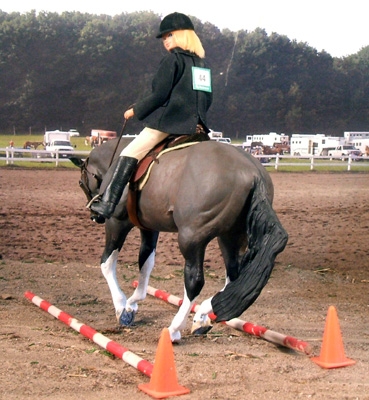
English Trail Arena
Stock Breed Entry
Our Gal Sal shown as a Grulla Minimal Tobiano Paint Mare and is a Breyer Rugged Lark CM. Shown by Sue Sudekum with the comment of: English Arena Trail: Backing between two ground poles.
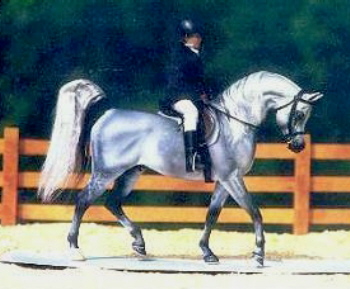
English Trail Arena
Arabian Breed Entry
Datelis Amadeus shown as a Grey Arabian Stallion and is a King’s Ransom Resin. Shown by Betty Hook with the comment of: Trotting calmly over obstacle.

English Trail Arena
TB/WB or Sporthorse Breed Entry
LW Constant Comment shown as a Dark bay, Oldenburg mare and is a Constance resin. Shown by Linda Westphal with the comment of: Constant Comment is looking at obstacle as she steps over.

English Trail Arena
Other Breed Entry
Ballyshannon shown as a Dark grey Connemara mare and is a Ballycor resin painted by Sherry Clayton. Shown by Robin Nere with the comment: Calmly walking over bridge. Connemara’s are shown unplaited and with legs not shaven.
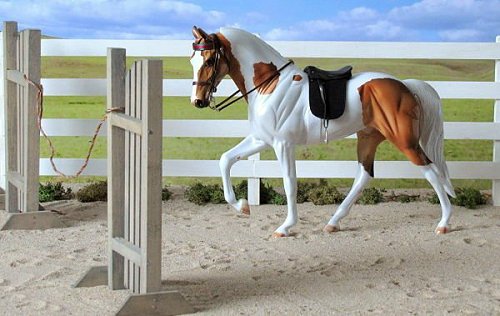
English Trail Arena with Saddleseat Tack
Moonshine Fandango shown as a Palomino Tobiano TWH is an OF PS TWH. Owned and shown by Mona McGraw with the comment: Horse is approaching the arena trail gate in order to negotiate the obstacle.
Doll Rider Correct Seat and Hold the Reins Correctly:

The reins are held between the ring fingers and pinkies with the thumbs solidly on top as they exit the hands. The grip is firm. Close the fingers for optimum communication and safety. Hold the hands just above the horse’s withers, in front of the saddle. Tip the thumbs toward each other at a 45-degree angle. Bend the elbows just enough to create a straight line through the forearms, hands, and reins to the horse’s mouth.
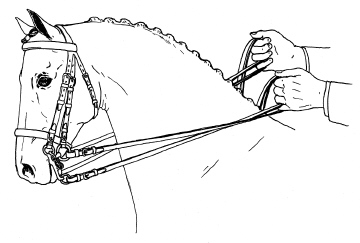
Double Bridle Reins – 2 and 2 Method. Most common handle hold in model horse hobby. It is advised that you put in your comment line what hold your set up is so that judge’s know you understand the three styles on holding the reins.

Double Bridle Reins – 3 in 1 Method. A true challenge for model horse hobbyists and doll rider’s with razor cut slips in the fingers of the hands. Left side curb goes directly back to hand and enters under ring finger with the left snaffle rein coming directly back and entering under the pinky finger with rein crossing over the curb rein. Right side curb rein goes directly back and enters under the middle finger of the left hand with all three reins coming up thru hand and out over the of the index finger with bight cascading down the right side. The right side snaffle goes directly and enters the hand under the ring finger, up into the hand and out over the top of the index finger with the bight draping down the right side. The look gives an ‘X’ to reins the left side of horse’s neck but a two independent rein look to the right side but only one rein going into the right hand. Very tricky set up.
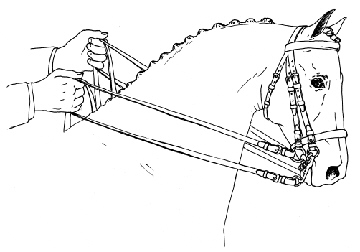
Double Bridle Reins – Fillis Method. The Fillis method of holding the reins is when the curb reins enter the rider’s hand from the bottom, around the little fingers and up to the second joint of the index fingers while the snaffle enters the fist from above over the index fingers. Each hand holds two reins.

